Simply put, a magnetosphere is the region where a planet’s magnetic field is dominant. Interplanetary space, on the other hand, is dominated by the Sun’s magnetic field and the solar wind. A strong magnetic field can protect a planet from the solar wind and from coronal mass ejections by deflecting high-energy particles. Mercury, Earth, Jupiter, Saturn, Uranus, and Neptune each have an intrinsic magnetosphere due to their internal magnetic fields. Venus and Mars, on the other hand, lack a global magnetic field, which might have been responsible for Mars losing its atmosphere due to solar wind sputtering.
Today’s Astrobite is an overview of the major features of each magnetosphere. For more detail, the reader is directed to the many links throughout and technical references included at the end.
Earth: Opening up the Magnetosphere
Earth’s magnetosphere, unsurprisingly, is the most studied of any in the Solar System. Figure 1 depicts its overall structure. Earth’s magnetopause—the boundary between the magnetosphere and the solar wind environment—is typically located at 10 Earth radii on the Sun-facing side and around 100 earth radii in the magnetotail.
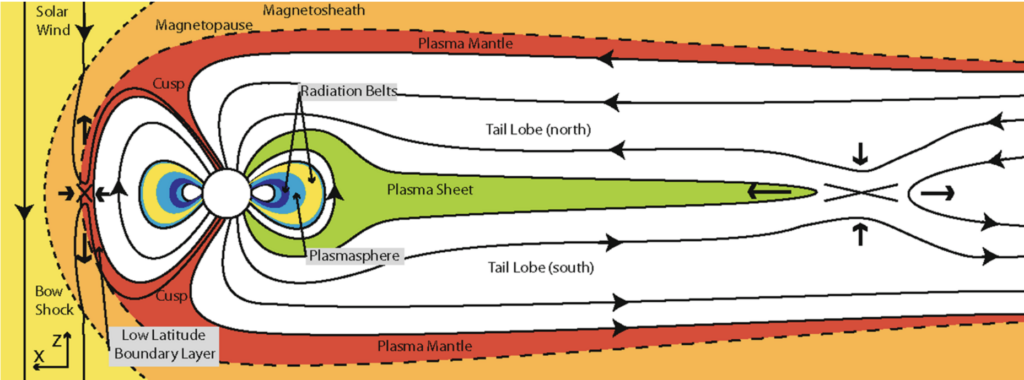
Though the Earth is protected by its magnetic field, the magnetosphere contains plenty of plasma. Head to the Arctic Circle and you’ll see it in action: the Aurora is caused by high energy ions entering the atmosphere and exciting neutral gas particles. In fact, all the Solar System’s magnetospheres are filled with plasma particles drifting in response to the magnetic field. A prominent example of these drift patterns are the Van Allan radiation belts, which encircle Earth and were explored from 2012 to 2019 by a pair of similarly named probes.
The drifting ions and elections set up a complex system of electric currents. You can fill a textbook with descriptions of magnetospheric and ionospheric currents (they have), it’s such a complex system.
The primary source of plasma within the magnetosphere is ultimately the solar wind, but for many years it was not obvious how solar wind particles could penetrate the magnetopause. In 1961, Jim Dungey published the “open model of the magnetosphere.” In his two-page letter, he theorized that magnetic field reconnection is one way for solar wind particles to enter the magnetosphere. Figure 1 shows an example of reconnection toward the left side, where the vertical interplanetary magnetic field line breaks in two and joins with the Earth’s magnetic field line at the location of the “X.” A proton gyrating around the interplanetary field line could suddenly find itself inside the Earth’s magnetosphere, free to gyrate around Earth’s magnetic field line.
Over the course of the 11-year solar cycle, the intensity of the solar wind varies. In extremely rare cases, the Sun will release an intense burst of plasma, called a coronal mass ejection. If it impacts the Earth’s magnetosphere it would cause extremely rapid reconnection: a geomagnetic storm. One of the most powerful in recorded history is the 1859 Carrington Event—if it happened today, most of the world could experience a months-long blackout. Hours after dayside reconnection, even a small event, a second reconnection occurs in the magnetotail, marked with a big “X” in Figure 1. This releases more energy from the magnetic field back toward Earth and is called a substorm.
Mercury: The Unexpected Magnetosphere
Most of the small objects in the Solar System (e.g., Mars, the Moon, Pluto) have no magnetic field today because their cores are solid and can’t generate a dynamo. Mercury, owing to its proximity to the Sun, still has a liquid outer core. Being close to the Sun also means Mercury feels a stronger solar wind pressure—7 times stronger than the solar wind at Earth. With a core that outputs a magnetic field only 1% of Earth’s and a strong solar wind to battle against, Mercury is only capable of maintaining a tiny magnetosphere. Figure 2 shows just how tiny: it would fit completely inside Earth!
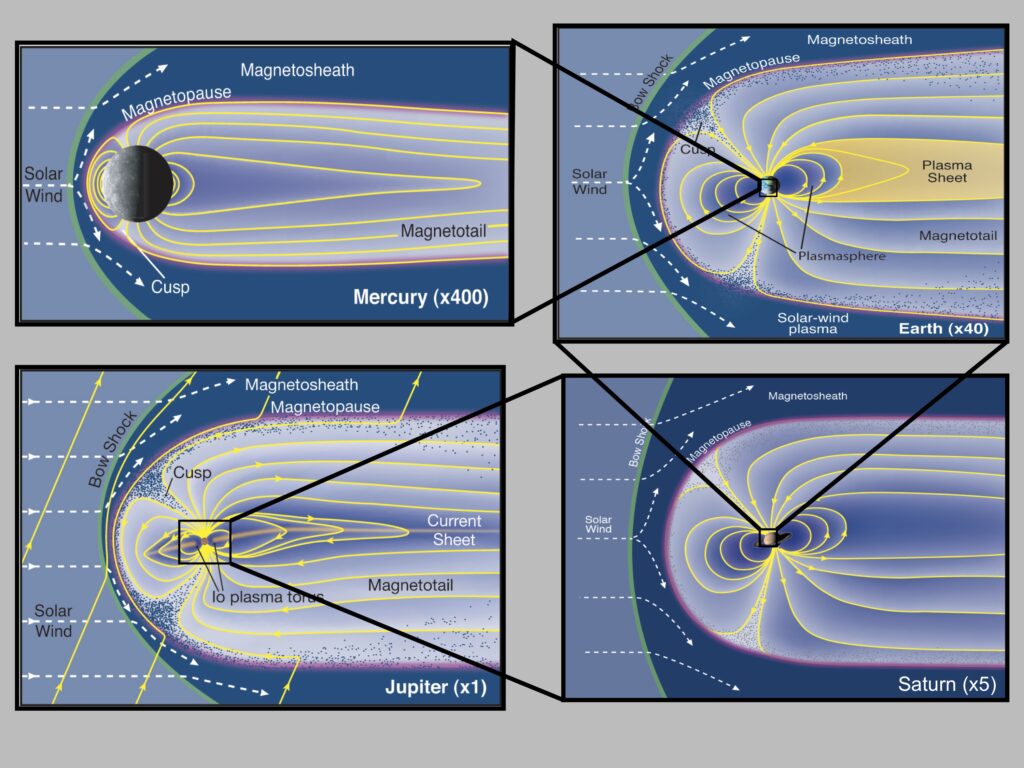
NASA’s MESSENGER mission orbited Mercury from 2011 to 2015. In that time, it mapped the magnetic field in high resolution and found Mercury’s magnetosphere is highly dynamic, being at the mercy of the Sun’s flares. Possibly the most surprising discovery from MESSENGER is that Mercury is shrinking!
BepiColombo, a joint mission between ESA and JAXA, is en route to Mercury and will arrive at Mercury in 2025. It contains a host of instruments to measure magnetic fields, ions, elections, and dust as it orbits, with the aim of better understanding the unusual characteristics of Mercury’s magnetosphere.
Jupiter: The Big One
It’s a little cheeky, but planetary scientists love to say that Jupiter’s magnetosphere is the largest object in the Solar System. A good follow-up line is to say that if we could see Jupiter’s magnetosphere at night, it would be two to three times larger than the moon. Jupiter can create such a large magnetosphere because it has a magnetic field 20,000 times Earth’s and feels a solar wind pressure of only 4% of the pressure at Earth.
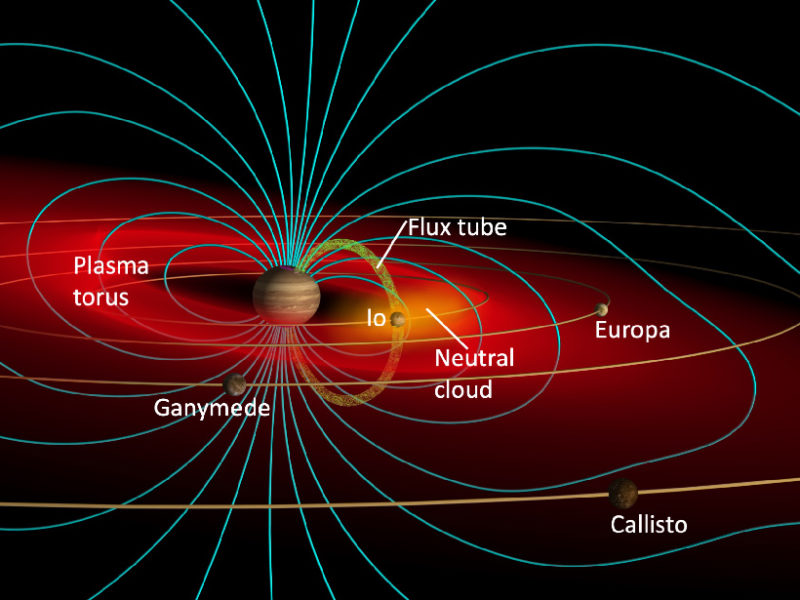
Within Jupiter’s magnetosphere, close to the planet itself, is an environment of ionized sulfur and oxygen atoms. The source of these atoms is the innermost Galilean moon Io, which is volcanically active but has no atmosphere. Io’s volcanoes release one ton of sulfur dioxide (SO2) per second, which ends up orbiting Jupiter in a donut-shaped ring. The sulfur dioxide is broken apart and then ionized into oxygen, sulfur, and free elections that reside in the Io plasma torus region, shown in Figure 3.
Jupiter rotates incredibly fast (every 10 hours) but the plasma can’t keep up. Jupiter tries to pull the plasma along with a network of electric currents, some of which direct elections down into the atmosphere along a flux tube, creating the brightest aurorae in the Solar System.
Jupiter’s magnetotail takes huge to a new level, measuring approximately 5 AU (the same as the Jupiter-Sun distance) and stretching all the way to Saturn’s orbit! Once every twenty years, for a time period of months, Saturn passes through Jupiter’s magnetotail, which is a completely different space environment from the normal solar wind conditions. In fact, this event is happening right now.
Saturn: A Rare Opportunity Emerges
Saturn, like Jupiter, has a large magnetosphere due to a magnetic field 600 times stronger than Earth’s. The Cassini mission to Saturn (2004-2017) discovered that the moon Enceladus is the source of most of the plasma in Saturn’s magnetosphere. Enceladus’ geysers pump out hundreds of kilograms of water vapor every second, which is dissociated and ionized to become the bulk of the plasma environment.
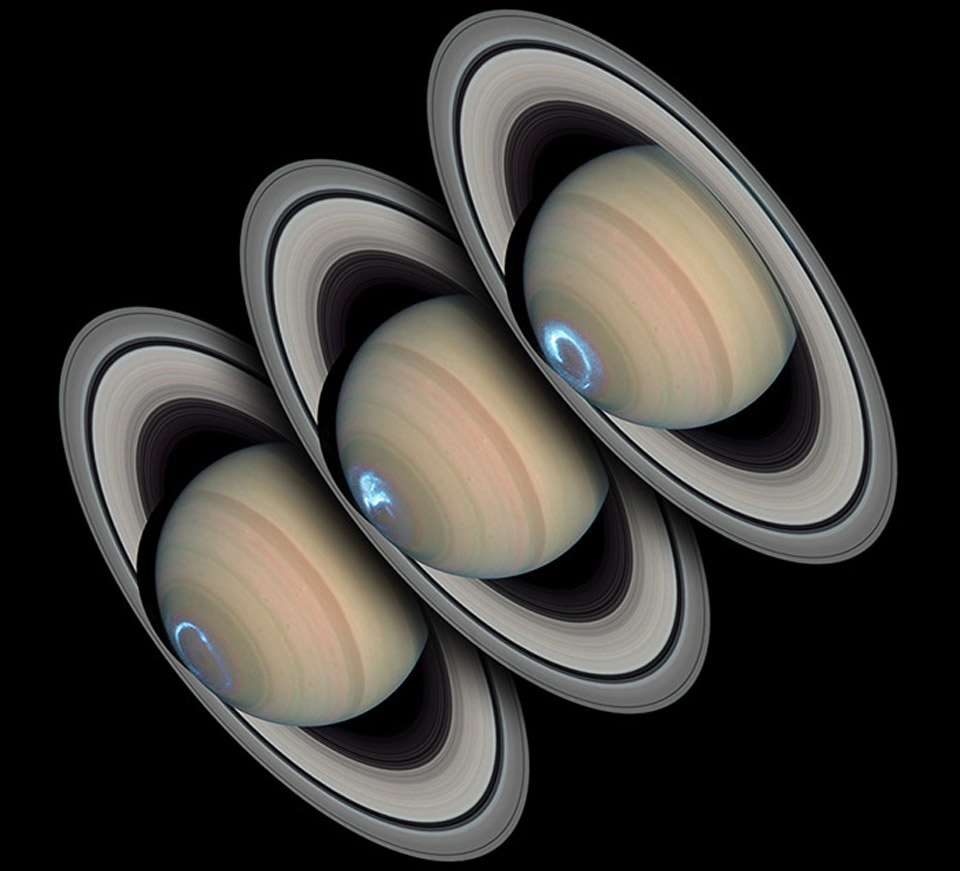
As mentioned above, Saturn is passing through Jupiter’s magnetotail between approximately October and December of 2020. During this time, Saturn will feel less plasma pressure than normal from the solar wind directly. Yes, you read that right; Jupiter’s magnetotail actually has a lower density of ions than the solar wind. Along the tail, Jupiter’s magnetic field holds off the solar wind from entering but very few of the plasma particles close to Jupiter itself travel all the way down the tail, leaving the plasma density incredibly low.
The magnetotail “flaps” like a windsock in the solar wind, meaning Saturn passes in and out of it many times during this event. A team of astronomers led by Jonny Nichols is currently using the Hubble Space Telescope to observe Saturn’s UV aurora and similar efforts are underway to observe the x-ray aurora with Chandra. They theorize that in the presence of less plasma than usual, Saturn’s magnetosphere will puff up, changing the typical pattern of aurorae. A preliminary image is available on Twitter but results are still underway.
The alignment of Jupiter and Saturn, called conjugation, is happening at a time when Earth is near the winter solstice (December 21), meaning Jupiter and Saturn will be incredibly close in the night sky. Take a look shortly after sunset and you’ll be able to see Jupiter and Saturn (brighter than any other stars) barely separated, for the first time in 800 years.
Uranus: The Light Switch Magnetosphere
Most planets have moderate obliquities (tilts) and their magnetic poles lie within about 10º of their geometric poles. Uranus violates both of these patterns. It is famously tilted at 98º and its magnetic axis is a further 59º tilt. Near the solstice, when Uranus’ pole faces directly toward the Sun for years, its magnetic field exhibits a “tumbling” pattern you can see in Figure 5.
When the magnetic pole is pointing toward the Sun, solar wind particles can easily stream into the open magnetosphere at the cusp. Other times, the magnetosphere is closed and the low solar wind density particles are easily deflected. Researchers describe Uranus’ magnetosphere as an “on/off switch.”
Neptune: The Asymmetric Magnetosphere
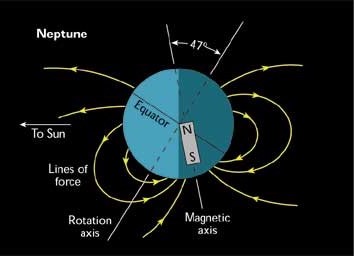
Neptune does not have the same (potentially) violent history as Uranus, with a modest 30º obliquity, and yet, it too has a strange magnetic field orientation. Neptune’s magnetic field is tilted at 47º relative to its spin axis and is offset from the center of the planet by about half its radius. Figure 6 shows just how off-center Neptune’s magnetic field is, which results in a highly asymmetric magnetosphere.
The only direct data currently available about the magnetospheres of Uranus and Neptune is from Voyager 2 in the 1980s, which has continued to yield incredible discoveries. Many astronomers are hoping that NASA approves a mission to the Ice Giants within the next decade, which would include an extensive effort to better understand their magnetospheres, among many other objectives.
Magnetospheres are difficult to study because they cannot be imaged directly. Even indirect methods of observing them, such as UV aurorae, are imprecise and irregular. The greatest improvements have come from in situ measurements via spacecraft: the Van Allen Probes, MESSENGER, Juno, Cassini, Voyager 2, and others. As NASA, ESA, and other space agencies plan for more and more missions in the 2020s and beyond, we can expect these sorts of measurements to continue to improve our understanding of magnetospheric dynamics throughout the Solar System.
Technical resources on magnetospheres:
- Russell, C. T. (1993). Planetary magnetospheres. Rep. Prog. Phys. 56 687.
- Cravens, T. E. (2004). Physics of Solar System Plasmas. United Kingdom: Cambridge University Press.
- Many additional resources can be found here: https://lasp.colorado.edu/home/mop/bibliographies/planetary-magnetospheres/
Astrobite edited by Keir Birchall and Marissa Vogt.
Cover image credit: F. Bagenal & S. Bartlett.




